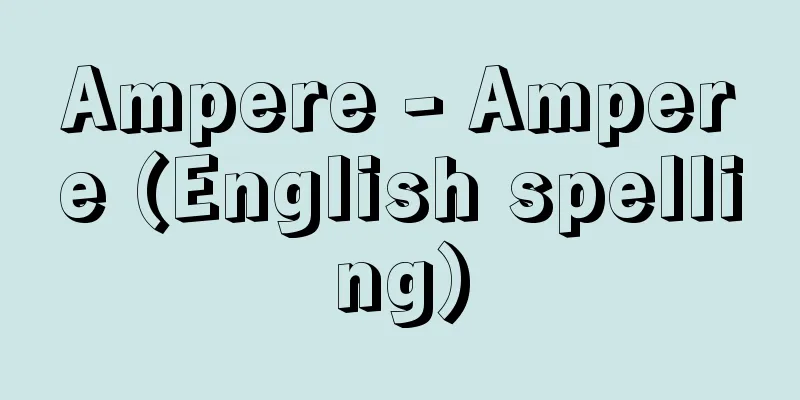Ampere - Ampere (English spelling)

|
It is the unit of electric current in the International System of Units (SI), and is one of the base units. Its symbol is A. The current definition is "a constant electric current that flows through two infinitely long linear conductors, each of which has an infinitely small circular cross-sectional area and is placed in parallel with each other at a distance of one meter in a vacuum, exerting a force of 2/10 million Newtons on each meter of the length of the conductors." This definition was decided at the 9th General Conference on Weights and Measures in 1948, but before that, it was defined as "a constant electric current that passes through an aqueous solution of silver nitrate and separates 0.00111800 grams of silver per second." This was decided at the International Electrotechnical Commission in 1908, and is called the international ampere, while the current definition is called the absolute ampere. The relationship between the two is 1 international ampere = 0.99995 absolute amperes. The value of amperes can be accurately measured using an ammeter balance, but in reality it is calculated from the values of voltage and electrical resistance, i.e., volts and ohms, using Ohm's law. In Japan, the international ampere was used until the Electrical Measurement Act was integrated into the Metrology Act in 1966. The name ampere comes from the achievements of the French physicist Ampere. The ampere is also used as a unit of magnetomotive force. In this case, it is defined as "the magnetomotive force that occurs when a constant current of 1 ampere flows through a closed circuit with one turn." When it is necessary to distinguish the unit of magnetomotive force, the ampere, from the unit of current, it is called the ampere turn. [Koizumi Kesakatsu and Imai Hidetaka] [Reference] | |Source: Shogakukan Encyclopedia Nipponica About Encyclopedia Nipponica Information | Legend |
|
国際単位系(SI)の電流の単位で、基本単位の一つである。記号はAで表す。現在の定義は「真空中に1メートルの間隔で平行に置かれた、無限に小さい円形断面積を有する無限に長い2本の直線状導体のそれぞれを流れ、これらの導体の長さ1メートルごとに力の大きさが1000万分の2ニュートンの力を及ぼし合う不変の電流」とされている。この定義は1948年(昭和23)の第9回国際度量衡総会で決められたものであるが、それ以前は、「硝酸銀の水溶液を通過し、毎秒0.00111800グラムの銀を分離する不変電流」と定義されていた。これは1908年に国際電気標準会議で定められたもので、これを国際アンペアといい、現在の定義のものを絶対アンペアという。両者の間の関係は アンペアの値は電流天秤(てんびん)によって正確に測ることが可能であるが、実際には電圧と電気抵抗の値、すなわちボルトとオームから、オームの法則によって計算される。 日本では1966年(昭和41)電気測定法が計量法に統合されるまで国際アンペアを用いていた。なお、アンペアの名称はフランスの物理学者アンペールの業績にちなんでいる。 アンペアはまた起磁力の単位にも用いられる。この場合の定義は「1回巻きの閉回路に1アンペアの不変の電流が流れるときに生ずる起磁力」とされている。なお、起磁力の単位のアンペアを、電流の単位のアンペアととくに区別する必要があるときは、アンペア回数ampere turnという。 [小泉袈裟勝・今井秀孝] [参照項目] | |出典 小学館 日本大百科全書(ニッポニカ)日本大百科全書(ニッポニカ)について 情報 | 凡例 |
<<: Ambedkar - Bhimrao Ramji Ambedkar
Recommend
Site of Iksan Royal Palace - Ekisan Royal Palace Site
…The area of Iksan, centered around Geumma-myeo...
Froghopper
...The bubbles of the larvae are very conspicuous...
Mobile testicles - Mobile testicles
…However, after that, it is almost impossible to ...
Homtsuwake no Mikoto - Homtsuwake no Mikoto
According to the Kojiki and Nihon Shoki, he was th...
Yamagiwa Katsusaburo - Yamagiwa Katsusaburo
Pathologist. Born in Ueda as the third son of Yam...
Tschermak, E. (English spelling) TschermakE
…Mendel's most important contribution was his...
Iron-containing bodies
...Asbestosis progresses insidiously and slowly, ...
Aganooki Oil and Gas Field - Aganooki Gas Field
Discovered in 1972, this is Japan's first full...
Cirsium maritimum
…[Hiroshi Aramata]. … *Some of the terminology th...
Hagenomyia micans (English)
...It becomes a pupa in a few days and emerges in...
Meson Factory (English spelling)
Pions and the muons produced in their decay proces...
Ikitsuki Island
An island located in the north of Hirado Island i...
Whig
…The origin of the modern political party is ofte...
Reichsbank
Germany's central bank until the end of World ...
Hominization
Phenomena that have undergone continuous change in...









